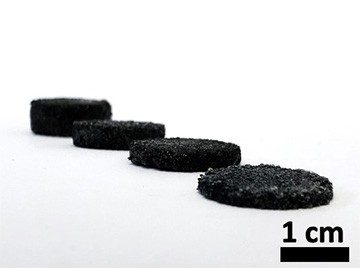FOR IMMEDIATE RELEASE | August 04, 2022
Sponge-like electrodes inspired by sugar cubes could improve medical monitoring
To monitor heart rhythms and muscle function, doctors often attach electrodes to a patient’s skin, detecting the electrical signals that lie beneath. These impulses are vital to the early diagnosis and treatment of many disorders, but currently available electrodes have limited function or are expensive to manufacture. Researchers reporting in ACS Nano, however, have now developed a low-cost, spongy version with improved signal detection that’s made with a surprising template — a sugar cube.
The current gold-standard electrodes for electrophysiologic monitoring rely on a silver disc that contacts the skin through a conductive gel. These electrodes are critical tools for detecting abnormal electrical signals linked to health issues, such as heart attacks, brain disorders or neuromuscular diseases. These devices are not without their drawbacks, however. They are rigid and cannot conform well to the skin, particularly when the patient is physically active, reducing signal quality. In addition, the conductive gel dries quickly, preventing long-term monitoring and rare-event detection. Addressing these challenges, researchers have designed soft electrodes that better conform to the skin, as well as microneedle-based versions that physically penetrate the skin, but these are expensive to manufacture, limiting their widespread use. So, Chuan Wang and colleagues wanted to develop a low-cost sponge-like electrode that would offer more consistent and resilient skin contact.
To make the new device, researchers started with commercially available sugar cubes, which they molded into a template that was dipped into liquid polydimethylsiloxane (PDMS). The PDMS became a solid structure after a curing step. They then dissolved the sugar with hot water and coated the sponge’s micropores with a conductive thin film to form the electrode.
Because the micropores allowed the spongy material to have increased contact area with the skin, the new device showed strong signal intensity and reduced noise when compared with standard electrodes. The micropores also helped the device carry more conductive gel, which kept them from drying out as quickly and losing signal, compared to standard versions. The gel also acted as a shock absorber, reducing the negative impacts of patient movement on skin-electrode contact and ensuring signal detection. The researchers tested the ability of the sponge device to monitor uterine contractions during labor and found it performed as well as, or better than, a conventional electrode. As a low-cost, flexible alternative, sponge electrodes expand the possibilities for wearable health care applications, including use in medical exams that require patients to move, or for long-term monitoring of people at home or at work, say the researchers.
The authors acknowledge funding from the Bill & Melinda Gates Foundation.
To automatically receive press releases from the American Chemical Society, contact newsroom@acs.org.
Note: ACS does not conduct research, but publishes and publicizes peer-reviewed scientific studies.
Media Contact
ACS Newsroom
newsroom@acs.org


